


xxxxxThe Eiffel Tower in Paris, the work of the French engineer Gustave Eiffel, was built as the entrance arch to the World Fair, held in the city in 1889. Made of high quality wrought iron, this huge lattice-type construction was the highest structure in the world (324 metres) until the building of the Chrysler Building in New York in 1930. At first it came in for some harsh criticism, being seen as a blot on the landscape, but today the tower is known the world over, and has come to be seen as the symbol of Paris and, indeed, of France itself.
THE EIFFEL TOWER 1889 (Vc)
Acknowledgements
Cartoon: published in the French newspaper Le Temps in February 1887, artist unknown. Hitler: date and artist unknown. Eiffel: by the French photographer Nadar (1820-1910) – Caisse Nationale des Monuments Historiques, Paris. Map (Panama): licensed under Creative Commons – travel.wikia.com/wiki/Panama. Bartholdi: date and artist unknown – Statue of Liberty National Monument, Liberty Island, New York. Statue: 1884, artist unknown. Dedication: by English-born American artist Edward Moran (1829-1901), 1886 – Museum of the City of New York.
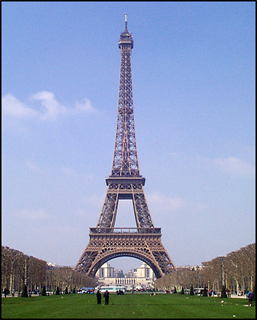 xxxxxThe Eiffel Tower was built as the entrance arch to the World Fair, held in Paris in 1889, the centenary year of the outbreak of the French Revolution. Work on this colossal undertaking began in January 1887, and took two years and two months to complete. Designed by the French engineer Gustave Eiffel, it was made up of more than 9,400 tons of “puddle” iron (high quality wrought iron) and given a lattice construction to minimise wind resistance. Over 18,000 pieces were manufactured and then assembled upwards - like a gigantic 3D jig-saw puzzle - by means of two and half million rivets.
xxxxxThe Eiffel Tower was built as the entrance arch to the World Fair, held in Paris in 1889, the centenary year of the outbreak of the French Revolution. Work on this colossal undertaking began in January 1887, and took two years and two months to complete. Designed by the French engineer Gustave Eiffel, it was made up of more than 9,400 tons of “puddle” iron (high quality wrought iron) and given a lattice construction to minimise wind resistance. Over 18,000 pieces were manufactured and then assembled upwards - like a gigantic 3D jig-saw puzzle - by means of two and half million rivets.
xxxxxWhen completed the tower was 324 metres high and, at the top, provided a visibility of 42 miles on a clear day, and swayed 15 centimetres in a strong wind. At that height it was twice as tall as the world’s highest structure at that time - the Washington Memorial - and it was not until 1930 with the building of the Chrysler Building in New York that it lost its record. Then two years later, following the completion of The Empire State Building in New York, it became the third tallest structure in the world. Built on the Champs de Mars, the original intention was dismantle the whole structure and sell it for scrap metal when the lease ran out after twenty years, but it was eventually decided to retain it to assist in the transmission of radio waves. Today both radio and television stations broadcast their signals from the top of the tower.
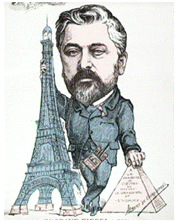 xxxxxWhen completed this huge metal structure was not without its critics. Indeed it was generally seen as an eyesore. One newspaper spoke about this “black blot and odious shadow”, and that particular article was signed, amongst others, by the composer Charles Gounod and the novelist Alexandre Dumas. And the writer Guy de Maupassant is alleged to have said that he had his lunch in the tower’s restaurant each day because that was the one place where he couldn’t see the tower itself! But there were those who took a different view. The American inventor Thomas Edison, for example, visited the tower in 1889 and, via the guestbook, applauded Eiffel for his “gigantic and original specimen of modern engineering”. And over the years public feeling towards this huge, distinctive structure slowly changed. Today it is known the world over, and is seen not only as a symbol of Paris - the City of Light - but also of France itself. In 2002 records showed that it had been visited by more that 200 million people!
xxxxxWhen completed this huge metal structure was not without its critics. Indeed it was generally seen as an eyesore. One newspaper spoke about this “black blot and odious shadow”, and that particular article was signed, amongst others, by the composer Charles Gounod and the novelist Alexandre Dumas. And the writer Guy de Maupassant is alleged to have said that he had his lunch in the tower’s restaurant each day because that was the one place where he couldn’t see the tower itself! But there were those who took a different view. The American inventor Thomas Edison, for example, visited the tower in 1889 and, via the guestbook, applauded Eiffel for his “gigantic and original specimen of modern engineering”. And over the years public feeling towards this huge, distinctive structure slowly changed. Today it is known the world over, and is seen not only as a symbol of Paris - the City of Light - but also of France itself. In 2002 records showed that it had been visited by more that 200 million people!
xxxxxIncidentally, the tower was originally designed as the entrance arch for the World Fair to be staged in Barcelona, Spain, in 1888, but the authorities there rejected it as being too strange and too expensive. ……
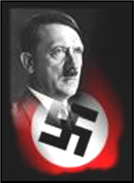
xxxxx……xWhen the Germans occupied Paris in June 1940 (during the Second World War) the Swastika was flown from the top of the tower, but when Hitler visited the site he chose to stay on the ground - giving rise to the saying that he conquered France but failed to conquer the tower. When the Allies were advancing on Paris in 1944 he gave the order that the tower should be destroyed, but it was not carried out. ……
xxxxx……xToday there are many Eiffel-inspired towers across the world, including ones at Las Vegas, Tianduching in China, and at the Epcot Centre in Florida. The Blackpool Tower in England, also completed in 1889, was designed on similar lines, but it was only half the height and was not free-standing.
Vc-1881-1901-Vc-1881-1901-Vc-1881-1901-Vc-1881-1901-Vc-1881-1901-Vc-1881-1901-Vc
xxxxxThe French engineer Gustave Eiffel (1832-1923), working from Paris and specializing in the design and construction of large metal structures, gained a world-wide reputation for his revolutionary bridge building. During his career he built many bridges in France and overseas, including the Maria Pia Bridge at Oporto in Portugal in 1877, and the great viaduct at Garabit in the Massif Central, completed in 1884. In the meantime he constructed the internal iron framework for the making of the Statue of Liberty, beginning in 1875, and, as we have seen, he embarked on the building of the tower that bears his name in 1887. And it was in that year that he became involved in the construction of the Panama Canal, begun in 1881 to link the Atlantic and Pacific Oceans. When this scheme collapsed, he was implicated in the financial scandal that surrounded the leader of the project, Ferdinand de Lesseps, but he was cleared of any wrong doing in 1893. He devoted the last years of his life to the study of meteorology and the problems related to aerodynamics.
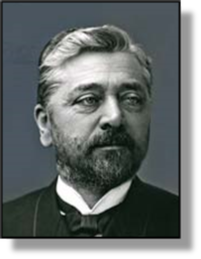 xxxxxThe French engineer Gustave Eiffel (1832-1923) was born in Dijon, eastern France. He attended the École des Arts et Manufactures in Paris and after working for the Great Railway Equipment Company he set up his own business in Paris in 1867. Specializing in the design and construction of large metal structures, he soon became known for his revolutionary bridge building. During his career he built many bridges in France, and undertook projects as far afield as Egypt, Vietnam and The Philippines. Notable among his works were the iron railway bridge over the River Garonne at Bordeaux, built in 1857 (where he was a pioneer in the use of compressed air in the making of underwater foundations); the Maria Pia Bridge over the River Douro, at Oporto, Portugal, finished in 1877 (then the longest arch bridge in he world); and the great viaduct at Garabit in the Massif Central, completed in 1884 (and then the highest bridge in the world).
xxxxxThe French engineer Gustave Eiffel (1832-1923) was born in Dijon, eastern France. He attended the École des Arts et Manufactures in Paris and after working for the Great Railway Equipment Company he set up his own business in Paris in 1867. Specializing in the design and construction of large metal structures, he soon became known for his revolutionary bridge building. During his career he built many bridges in France, and undertook projects as far afield as Egypt, Vietnam and The Philippines. Notable among his works were the iron railway bridge over the River Garonne at Bordeaux, built in 1857 (where he was a pioneer in the use of compressed air in the making of underwater foundations); the Maria Pia Bridge over the River Douro, at Oporto, Portugal, finished in 1877 (then the longest arch bridge in he world); and the great viaduct at Garabit in the Massif Central, completed in 1884 (and then the highest bridge in the world).
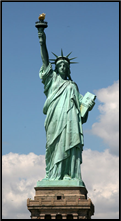 xxxxxIn the meantime Eiffel took a major part in a number of huge construction projects. In 1875, he was commissioned to build the internal iron framework for the making of the Statue of Liberty - fully completed ten years later - and, as we have seen, he embarked on the building of the tower that bears his name in 1887. And it was in that year that he became involved in the French attempt to build the Panama Canal in Central America, an ambi
xxxxxIn the meantime Eiffel took a major part in a number of huge construction projects. In 1875, he was commissioned to build the internal iron framework for the making of the Statue of Liberty - fully completed ten years later - and, as we have seen, he embarked on the building of the tower that bears his name in 1887. And it was in that year that he became involved in the French attempt to build the Panama Canal in Central America, an ambi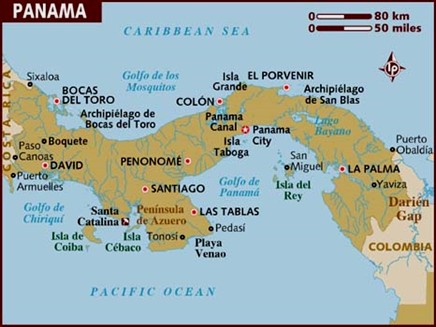 tious scheme begun in 1881 to connect the Atlantic and Pacific Oceans. He designed and began to construct some colossal locks for this undertaking, but the entire project collapsed in 1892 and, along with the project’s leader Ferdinand de Lesseps, he found himself charged with corruption. He was eventually cleared of any wrong doing by a French appeals court in 1893, but from then onwards he withdrew from commercial life and devoted himself to a study of meteorology and the problems related to aerodynamics.
tious scheme begun in 1881 to connect the Atlantic and Pacific Oceans. He designed and began to construct some colossal locks for this undertaking, but the entire project collapsed in 1892 and, along with the project’s leader Ferdinand de Lesseps, he found himself charged with corruption. He was eventually cleared of any wrong doing by a French appeals court in 1893, but from then onwards he withdrew from commercial life and devoted himself to a study of meteorology and the problems related to aerodynamics.
xxxxxIncidentally, Eiffel’s father was a German and the family name was Bonickhausen. However, on coming to live in France he found that the French had difficulty in pronouncing this name, so he adopted the name “Eiffel” after Eifel, the region of his birth in western Germany. ......
xxxxx…… Not all of Eiffel’s bridges were successful. In June 1891 his bridge at Bruckgut in Munchenstein, Switzerland, collapsed while a train was running over it. Some of the front carriages plunged into the river below, killing 73 people and injuring more than 170. The Munchenstein rail disaster, as it came to be known, was the worst railway accident up to that time. Later an inquiry into the incident found that the formula for “buckling” (a breakage caused by sudden stress), produced by the Swiss mathematician Leonhard Euler in 1757, had proved inadequate for the structure of this particular bridge.
Including:
Gustave Eiffel, The
Statue of Liberty and
Frédéric Auguste Bartholdi


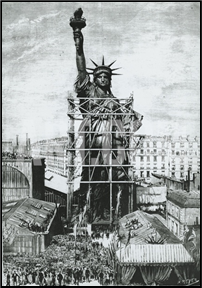 xxxxxThe architect who designed and directed the construction of the famous Statue of Liberty in New York’s harbour was the Frenchman Frédéric Auguste Bartholdi (1834-1904). He was born in Colmar, Alsace, and studied art in Paris from 1843 to 1851. He showed an interest in oil painting and water colour, but his main interest lay in sculpture and architecture, and once his studies were over he made a living making numerous patriotic monuments. Notable among these was his impressive The Lion of Belfort of 1880, carved out of the red sandstone of a hill overlooking the city of Belfort in eastern France.
xxxxxThe architect who designed and directed the construction of the famous Statue of Liberty in New York’s harbour was the Frenchman Frédéric Auguste Bartholdi (1834-1904). He was born in Colmar, Alsace, and studied art in Paris from 1843 to 1851. He showed an interest in oil painting and water colour, but his main interest lay in sculpture and architecture, and once his studies were over he made a living making numerous patriotic monuments. Notable among these was his impressive The Lion of Belfort of 1880, carved out of the red sandstone of a hill overlooking the city of Belfort in eastern France.
xxxxxIn 1855 he visited Egypt and, fascinated by the colossal ancient sculptors he saw there, returned in 1869 with the idea of building a gigantic figure, suitably draped and holding aloft a torch to illuminate the entrance to the newly opened Suez Canal. Inxfact, there was never enough money for such an ambitious scheme, but he then turned his attention to an idea put to him earlier by one of his friends, the French historian Édouard de Laboulaye (1811-1883). In 1865 he had suggested that the French people should present a statue as a symbol of liberty and opportunity to the people of the United States as a reminder of their mutual friendship, forged during the American War of Independence. In 1870 Bartholdi took up this idea, started on the design, and began fund raising to meet the cost. Then the following year he visited New York and selected Bedloe Island in the harbour (renamed Liberty Island in 1956) as a fitting site for this huge statue.
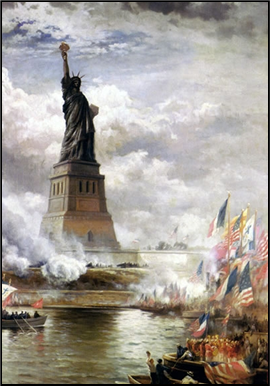 xxxxxConstruction began in 1875 and it was then that he commissioned the French engineer Gustave Eiffel to build the internal iron structure - the armature - upon which the exterior “skin” of the figure could be fixed. Hexdirected the building of the framework, but passed the detailed work over to his structural engineer Maurice Koechlin (1856-1946). The skin itself was made up of numerous copper sheets, hammered into shape by hand, and fashioned to fit the contours of the figure. Constructed in Paris, it was 46 metres high when completed in June 1884. It was then dismantled and the pieces (350 in total) were packed into boxes and sent to New York early the following year. It took four months to reassemble the statue and it was then dedicated as Liberty Enlightening the World in October 1886. Thexpainting, the work of the American marine artist Edward Moran (1829-1901), depicts the unveiling ceremony, conducted by President Grover Cleveland.
xxxxxConstruction began in 1875 and it was then that he commissioned the French engineer Gustave Eiffel to build the internal iron structure - the armature - upon which the exterior “skin” of the figure could be fixed. Hexdirected the building of the framework, but passed the detailed work over to his structural engineer Maurice Koechlin (1856-1946). The skin itself was made up of numerous copper sheets, hammered into shape by hand, and fashioned to fit the contours of the figure. Constructed in Paris, it was 46 metres high when completed in June 1884. It was then dismantled and the pieces (350 in total) were packed into boxes and sent to New York early the following year. It took four months to reassemble the statue and it was then dedicated as Liberty Enlightening the World in October 1886. Thexpainting, the work of the American marine artist Edward Moran (1829-1901), depicts the unveiling ceremony, conducted by President Grover Cleveland.
xxxxxIn June 1884 the Minister of the United States to France gave a banquet in honour of the French-American Union and in celebration of the completion of the statue. Ferdinand de Lesseps, the architect of the Suez Canal, as head of the Union, formerly presented the statue to the United States, trusting that “it might forever stand as a pledge of friendship between France and the Great Republic of the United States.” Later he travelled to America to speak at the dedication ceremony.
xxxxxIncidentally, thexpedestal was the work of the American architect Richard Morris Hunt (1827-1895). A plaque at its entrance has inscribed on it the words of The New Colossus, a sonnet composed by the Jewish-American poet Emma Lazarus (1849-1887) in 1883 to raise money for the building of the pedestal. The plaque was erected in 1903 and the final lines of the poem read:
Give me your tired, your poor,
Your troubled masses, yearning to breath free,
The wretched refuse of your teeming shore,
Send these, the homeless, tempest-tost to me.
I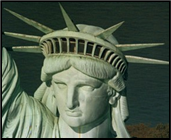 lift my lamp beside the golden door. ...…
lift my lamp beside the golden door. ...…
xxxxx…… It is said that Bartholdi modelled the facial features of the statue on those of his mother Charlotte Bartholdi, but there are other contenders. These include his wife and former mistress Jeanne-Emilie Bartholdi, and Isabella Eugenie Boyer, widow of the sewing machine magnet Isaac Singer. ……
xxxxx…… A quarter-size bronze replica of the Statue of Liberty, 35ft in height, stands on the Ile des Cygnes (Island of Swans), next to the Pont Grenelle, a bridge crossing the River Seine 1.5 ks south of the Eiffel tower. It was financed by French people living in the United States, and sent to France in 1889 to commemorate the centenary of the French Revolution.
xxxxxThe Statue of Liberty, a gift from the people of France to the United States, was erected on an island in New York harbour in 1886. Meant as a symbol of the friendship between the two nations, forged in the American War of Independence, it was designed and constructed by the French architect and sculptor Frédéric Auguste Bartholdi (1834-1904). The inner iron structure upon which the exterior copper plates were fixed was built by the French engineer Gustave Eiffel. Construction was begun in Paris in 1875 and completed ten years later. It was then dismantled and shipped to New York. Some 46 metres high, it was named Liberty Enlightening the World when dedicated in November 1886. The pedestal was the work of the American architect Richard Morris Hunt.






 xxxxxThe Eiffel Tower was built as the entrance arch to the World Fair, held in Paris in 1889, the centenary year of the outbreak of the French Revolution. Work on this colossal undertaking began in January 1887, and took two years and two months to complete. Designed by the French engineer Gustave Eiffel, it was made up of more than 9,400 tons of “puddle” iron (high quality wrought iron) and given a lattice construction to minimise wind resistance. Over 18,000 pieces were manufactured and then assembled upwards -
xxxxxThe Eiffel Tower was built as the entrance arch to the World Fair, held in Paris in 1889, the centenary year of the outbreak of the French Revolution. Work on this colossal undertaking began in January 1887, and took two years and two months to complete. Designed by the French engineer Gustave Eiffel, it was made up of more than 9,400 tons of “puddle” iron (high quality wrought iron) and given a lattice construction to minimise wind resistance. Over 18,000 pieces were manufactured and then assembled upwards - xxxxxWhen completed this huge metal structure was not without its critics. Indeed it was generally seen as an eyesore. One newspaper spoke about this “black blot and odious shadow”, and that particular article was signed, amongst others, by the composer Charles Gounod and the novelist Alexandre Dumas. And the writer Guy de Maupassant is alleged to have said that he had his lunch in the tower’s restaurant each day because that was the one place where he couldn’t see the tower itself! But there were those who took a different view. The American inventor Thomas Edison, for example, visited the tower in 1889 and, via the guestbook, applauded Eiffel for his “gigantic and original specimen of modern engineering”. And over the years public feeling towards this huge, distinctive structure slowly changed. Today it is known the world over, and is seen not only as a symbol of Paris -
xxxxxWhen completed this huge metal structure was not without its critics. Indeed it was generally seen as an eyesore. One newspaper spoke about this “black blot and odious shadow”, and that particular article was signed, amongst others, by the composer Charles Gounod and the novelist Alexandre Dumas. And the writer Guy de Maupassant is alleged to have said that he had his lunch in the tower’s restaurant each day because that was the one place where he couldn’t see the tower itself! But there were those who took a different view. The American inventor Thomas Edison, for example, visited the tower in 1889 and, via the guestbook, applauded Eiffel for his “gigantic and original specimen of modern engineering”. And over the years public feeling towards this huge, distinctive structure slowly changed. Today it is known the world over, and is seen not only as a symbol of Paris -
 xxxxxThe French engineer Gustave Eiffel (1832-
xxxxxThe French engineer Gustave Eiffel (1832- xxxxxIn the meantime Eiffel took a major part in a number of huge construction projects. In 1875, he was commissioned to build the internal iron framework for the making of the Statue of Liberty -
xxxxxIn the meantime Eiffel took a major part in a number of huge construction projects. In 1875, he was commissioned to build the internal iron framework for the making of the Statue of Liberty - tious scheme begun in 1881 to connect the Atlantic and Pacific Oceans. He designed and began to construct some colossal locks for this undertaking, but the entire project collapsed in 1892 and, along with the project’s leader Ferdinand de Lesseps, he found himself charged with corruption. He was eventually cleared of any wrong doing by a French appeals court in 1893, but from then onwards he withdrew from commercial life and devoted himself to a study of meteorology and the problems related to aerodynamics.
tious scheme begun in 1881 to connect the Atlantic and Pacific Oceans. He designed and began to construct some colossal locks for this undertaking, but the entire project collapsed in 1892 and, along with the project’s leader Ferdinand de Lesseps, he found himself charged with corruption. He was eventually cleared of any wrong doing by a French appeals court in 1893, but from then onwards he withdrew from commercial life and devoted himself to a study of meteorology and the problems related to aerodynamics.

 xxxxxThe architect who designed and directed the construction of the famous Statue of Liberty in New York’s harbour was the Frenchman Frédéric Auguste Bartholdi (1834-
xxxxxThe architect who designed and directed the construction of the famous Statue of Liberty in New York’s harbour was the Frenchman Frédéric Auguste Bartholdi (1834- xxxxxConstruction began in 1875 and it was then that he commissioned the French engineer Gustave Eiffel to build the internal iron structure -
xxxxxConstruction began in 1875 and it was then that he commissioned the French engineer Gustave Eiffel to build the internal iron structure - lift my lamp beside the golden door. ...…
lift my lamp beside the golden door. ...…

